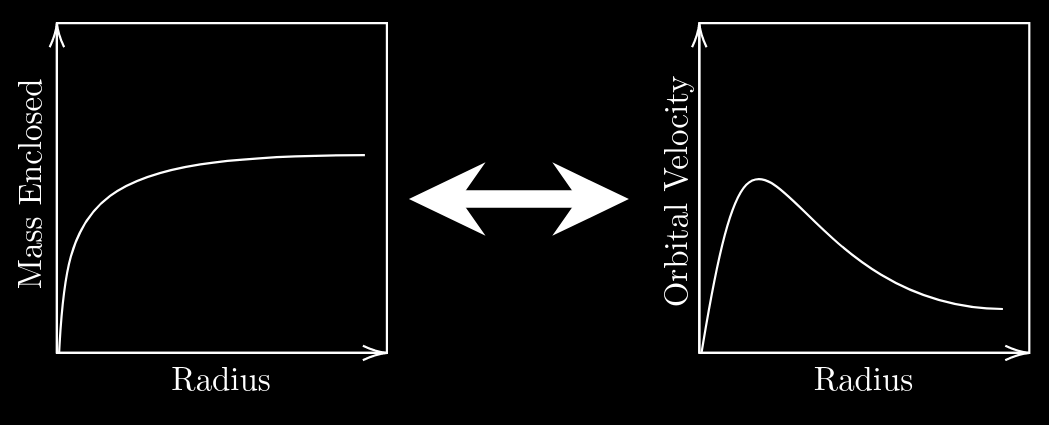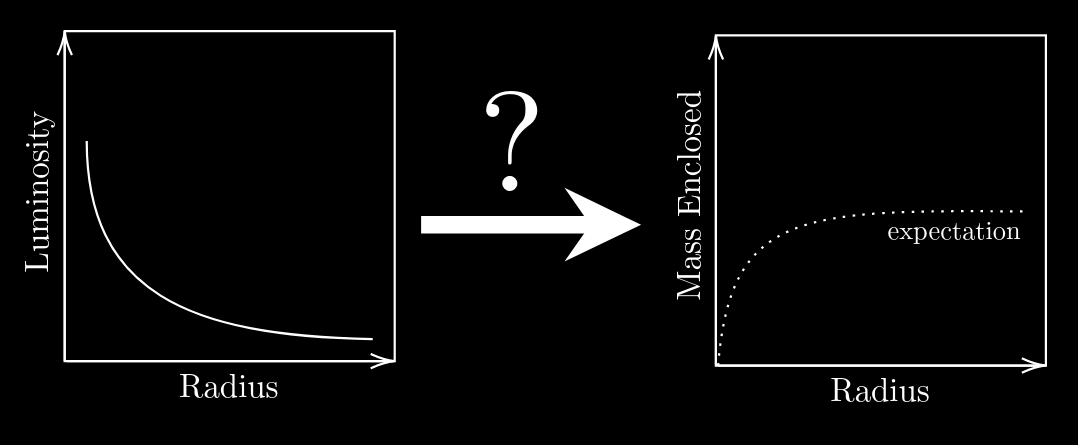What is Dark Matter?
MASS AND ORBITS
In our Solar system, planets orbit around the sun. The further away from the sun a planet is, the slower it’s orbital velocity: a relationship described by Kepler’s Law. From the laws of gravity, The total mass enclosed by an object’s orbit determines how fast that object orbits around. If you know one, then you can calculate the other.


MASS AND LUMINOSITY
How do we find mass in the universe? The assumption has been that luminous regions of space must contain matter (like a star, for example), and therefore mass. For a long time, astronomers have assumed that more luminosity implied more mass. However, it was not confirmed, and it prompted astronomers to take a closer look.

SPIRAL GALAXIES
In order to better understand the relationship between luminosity and mass, astronomers such as Vera Rubin started looking at the orbital velocities of stars in spiral galaxies. (Rubin 1983). The orbital velocities of galaxies at different distances from the center was recorded and could be used to calculate the enclosed mass. During these investigations, an unexpected and astounding discovery was made: stars were orbiting much more quickly than expected.

DARK MATTER
In most spiral galaxies, the center of the galaxy is the most luminous. The expectation was that most mass would be found at the center, and that stars would orbit around the center similar to the Solar System, following Kepler’s Laws. However, nearly all velocity curves were observed to rise quickly and remain flat or even slowly increase further out from the center.
There wasn’t enough luminous mass to explain these velocities. So, it was hypothesized that there must be non-luminous mass found in these galaxies, named Dark Matter.

OTHER RESOURCES
Homepage of Yoshiaki Sofue, who has links to papers and information about the galatic dynamics of dark matter: http://www.ioa.s.u-tokyo.ac.jp/~sofue/
Dataset of existing galaxy rotation curves used in the simulation, created by Yoshiaki Sofue: http://www.ioa.s.u-tokyo.ac.jp/~sofue/RC99/alldata.tar.gz
Astrobites article about Vera Rubin and her contribution to the discovery of Dark Matter: https://astrobites.org/2016/12/27/how-one-person-discovered-the-majority-of-the-universe-the-work-of-vera-rubin/
Vera Cooper Rubin (1928–2016): https://www.jstor.org/stable/10.2307/26660082
REFERENCES
Rubin, V.; Thonnard, W.K. Jr.; Ford, N. (1980). “Rotational Properties of 21 Sc Galaxies with a Large Range of Luminosities and Radii from NGC 4605 (R = 4kpc) to UGC 2885 (R = 122kpc)”. The Astrophysical Journal. 238: 471. Bibcode:1980ApJ…238..471R. https://www.doi.org/10.1086/158003.
Rubin, Vera C.; Ford, W. Kent, Jr. (1970). “Rotation of the Andromeda Nebula from a Spectroscopic Survey of Emission Regions”. Astrophysical Journal. 159: 379. https://www.doi.org/10.1086/150317.
Rubin, Vera C. (1983). “Dark Matter in Spiral Galaxies.” Scientific American. 248, no. 6 : 96-109.
Y. Sofue, Y. Tutui, M. Honma, A. Tomita, T. Takamiya, J. Koda and Y. Takeda. (1999). “Central Rotation Curves of Spiral Galaxies”. The Astrophysical Journal. 523: 136-146.